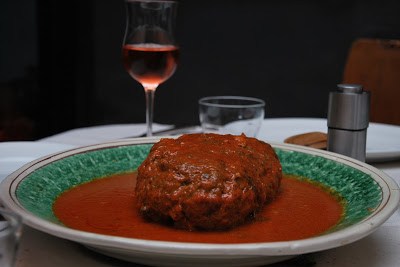I asked my butcher to mince some very lean beef for me – I was going to have it as steak tartare. I did not get around to using it and made a polpettone (a large meat ball/ loaf, called a purpittuni in Sicilian).
In previous posts I have written about polpette (meatballs) and braciole (meat rolled around a stuffing), and although making a polpettone is very similar to these recipes it gives me an opportunity to get a photo – visuals are helpful when cooking a recipe.
In this polpettone, I have placed some stuffing in the centre, as one would do when making a farsumagru (a large, thinly pounded steak of young beef, rolled around a stuffing) and this time I have used a few slices of cooked ham, small bits of pecorino and hard-boiled eggs. In Italy, cooked ham is called prosciutto and what we call prosciutto in Australia is known as prosciutto crudo (raw ham).
The older, Sicilian recipes rarely include wine in cooking (vinegar, yes) so the wine is optional.
I need to mention the platter. It is one of Giacomo Alessi’s ceramiche (ceramics, just I case you have not guessed).
I bought my very first in Caltagirone, Sicily’s most important centre for ceramics and where Alessi’s pottery is based. He has since established other outlets; I bought the one in the photo in Erice (central Sicily) last year and I purchased another in Palermo.
I love his ceramics, especially the ones with the bright green border; these are based on traditional and very old designs.
I am attracted to his use of strong colours, the ornamentation and images he uses, so evocative of the past. All my cousins and their offspring have the very old, original platters scattered around their homes (not Alessi’s, but he has reproduced and revived the old designs). They had belonged to Rosa, my paternal grandmother (Ragusa), but unfortunately when they were distributed within the family I was out of sight and out of mind. Apparently, one of the many uses for these platters was to dry conserva (rich tomato paste), which was placed to dry in the hot, Sicilian sun.
For the recipe complete with photos, see
HOW TO MAKE A POLPETTONE (in Sicilian Purpittuni or
Purpittuni)
MA2SBAE8REVW




